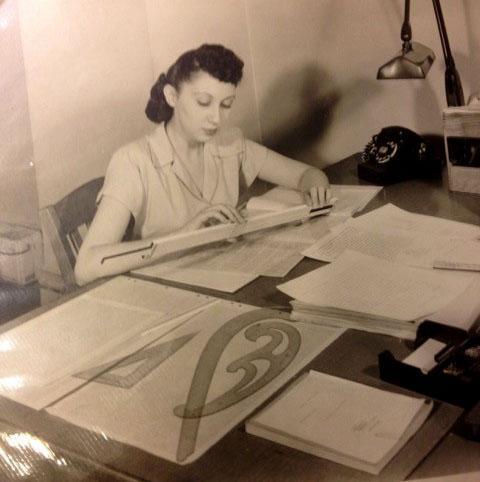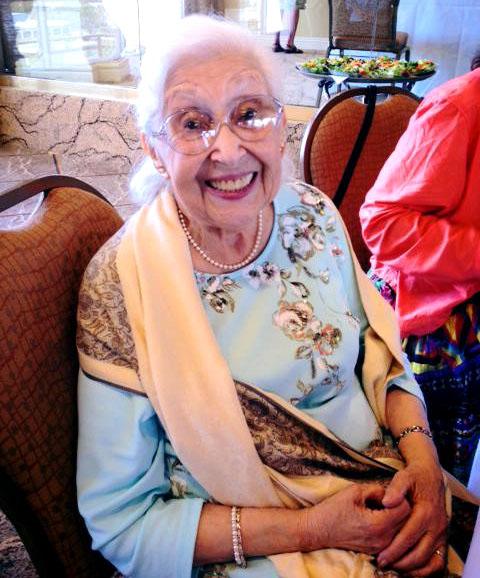STS gave 1942 finalist confidence to study engineering
Carol Bauer, a Westinghouse Science Talent Search 1942 alumna, worked as an engineer at a time when there were very few women in the sciences.
“At the time, it was a daring choice,” she said. Her experience in Westinghouse STS gave her the confidence to study engineering — and it’s paved the way for other women to follow.
Today, she continues to encourage girls into STEM through the Tech Trek program.
Diversity in STEM is crucial in today’s technological world, Carol said. “In my work experience, I found that men and women often take different approaches to problems. And working together, they end up with better decisions and directions for the work than one gender alone,” she said.

She became interested in science at a young age, from her father.
My father was very interested in science and we talked about it a lot starting when I was very young. My father was very encouraging about my entering the Science Talent Search and in my later plans to major in science. We were both most interested in the physical sciences. He died before I made the decision to go into engineering.
Her experiences with Westinghouse Science Talent Search were influential in her career path.
Originally I wanted to major in chemistry. Then I found out that one of the New York City colleges, CCNY, had recently opened their engineering school to women. This interested me when I thought it over, as I viewed engineering as a practical application of the achievements of science.
At the time, majoring in engineering was a daring choice. My experience with the Westinghouse Science Talent search gave me the confidence to make this decision.
There were very few woman in engineering then, and although their numbers have increased now, it is still a male dominated field. At the time, it was a daring choice and I know that my experience with the Westinghouse Science Talent search gave me the confidence to make this decision. This also paved the way for other younger women to follow.
Carol’s most memorable experience at STS 1942 was a conversation she had with Vice President Henry Wallace.
I wrote my paper on synthetic rubber, which was a subject of particular interest to the Vice President. There were two chemical methods under investigation for producing rubber, which was greatly needed by our armed forces. He asked me which process I wrote about and complimented me on making the same choice he did.
Carol worked at McDonnell Douglas, which is now Boeing, until 1993. She experienced the shift that women overall did in the workplace over the generations.
I applied for a job at McDonnell Douglas because changes in management made it necessary for me to leave my current job. Although both my degree and job experience were in chemical engineering, the ad I answered was for weight engineers but specified that they were interested in any applicants with degrees in science, math, or engineering. Aerospace was booming then and they were desperate for qualified people.
In those days there was no maternity leave and you had to leave your job and hope to find another one when you were ready to go back to work.
When the chief weights engineer interviewed me, he expressed interest in the job I had many years before as a technical reader for McGraw Hill College Textbook Series in the sciences. There, I did proofreading, editing, and rewriting as needed and was their only reader who read for content as well.
The interviewer at McDonnell Douglas questioned me about the work I did for McGraw Hill and then said that they would definitely make me an offer because what they needed in their department was, in his words “an engineer who could write and spell.” I thought that was very funny but found that they did indeed needed someone with both talents. Engineers are notoriously poor writers, at least they were at that time.
This job came through a recommendation from my manager at the job I had to leave, when I was about to give birth to my first child. In those days there was no maternity leave and you had to leave your job and hope to find another one when you were ready to go back to work. Although I tried to hold onto my job by working as a part-time consultant, my company would not accept that. So my manager, who liked my work very much, got me the job with the publisher where I could do most of the work at home.
I knew nothing about aircraft or weight engineering. I also had very limited knowledge of computer software, although I had some experience with hardware on the job I was leaving. At McDonnell Douglas, they assigned me to document the software for a new system they were about to acquire. It was a steep learning curve but I liked it and appeared to have an aptitude for learning and training our computer applications. I also wrote the user manual. I ended up as weights database manager for a major aircraft program as well as system manager for the weights engineering computer. A far cry from chemistry, but you never know the turns your career could make. With a good foundation in the basics of science and math, your job capabilities are flexible.

She is a longtime member of the Tech Trek program of the American Association of University Women (AAUW). The program sends middle school girls to science camps held on university campuses.
Tech Trek started because a study by AAUW found that girls start to fall behind boys in science and math around the 7th grade. Sending girls of that age to science camp inspires them and increases their interest in STEM.
The girls report back to us at our October meeting. The enthusiasm they show is heartwarming. The parents report that the girls mature and gain confidence even after such a short time in Tech Trek. Some parents are so enthused that they provide scholarships and dorm moms.
As for why STEM is important, I should think that is self-evident. It is a technical world now and needs qualified men and women to do the research and development of current and new technologies. In my work experience, I found that men and women often take different approaches to problems. And working together, they end up with better decisions and directions for the work than one gender alone. (Some biologists tell us that the proper usage in the preceding sentence should be “sex” not “gender,” as gender is a grammatical term. I am not that much of a purist).
For the Tech Trek program, we require an application, a questionnaire about personal aspects of the girl’s life, a letter of recommendation from a teacher, and an essay about why they think they should be chosen. These are evaluated by “readers,” and with multiple applicants from the same school, they are rated from 1 to 5. The top rated girls are sent to university campuses for a week where they are given a choice of activities and courses to pursue. Some of the campuses that the Torrance Branch of AAUW sends our top picks are University of California, Santa Barbara, Whittier College, and University of California, San Diego.
The girls mature and gain confidence even after such a short time in Tech Trek.
I became involved in AAUW when I first moved to California by meeting a member at a PTA meeting. The focus of the organization is education for girls and women. Sadly this is a major battle in some places in the world. At my first meeting, I was so impressed that I joined on the spot and have been a member on and off since 1960. At one point I was the program vice president for two years. There was a hiatus when my career took another direction when I went to McDonnell Douglas and I spent a lot of extra time learning the new disciplines that job required.
When I retired in 1993, I rejoined AAUW. When Tech Trek became such an important program, it was a natural for me to get involved. My involvement in the organization in general and in Tech Trek is of necessity somewhat limited now. My age has taken its toll on my body and I have a number of serious ailments. I am happy to say my brain function is still fine.
For a while, she’s stayed in contact with several friends from STS.
In the early years after STS 1942, I kept up with a number of others in my group. Bill Eastman and I corresponded for a number of years, especially when he was in Korea. We met again at the 50th reunion and a while after that when he was visiting in California.
I became friends with Lester Hollander who lived near me in the Bronx and we dated on and off while in college. I was at CCNY and he was at NYU. Seymour Linder and Eugene Avalone were fellow classmates at CCNY. I also became friends for a while with a 1943 STS-er, Howard Haftel. His family was friends with a friend of my father’s, and that was how we connected. As time goes by these connections tend to fade, especially in the days before email.
Carol encourages young people interested in science or math to work hard.
Don’t get overly distracted by social life which is often so compelling in the teen years. Although it is good to be fairly well-rounded and colleges like to see some involvement in more than just studies, learning well is the key. I met my husband in college and we limited the time we spent together in order to concentrate on our school work.
Math and science are not easy, and the more you concentrate on your schoolwork the better foundation you have for your future career. If you really love it, you enjoy concentrating on it.


